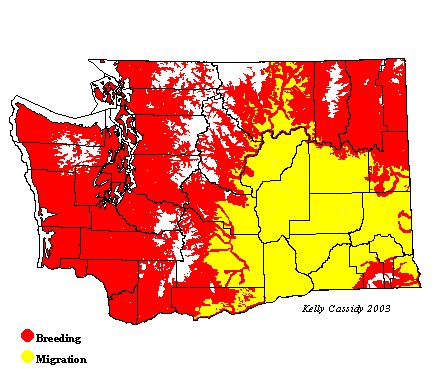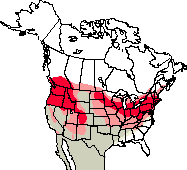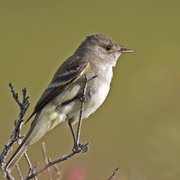Willow Flycatcher
General Description
The Willow Flycatcher is one of the largest flycatchers in the genus Empidonax, with a relatively flat forehead and distinct peak on the rear of its crown. It is gray in color, with buffy or light-gray wing-bars and an almost invisible white eye-ring. The lack of visible eye-ring helps distinguish it from the other Empidonax flycatchers. It has a pale breast and white throat, and the base of the lower mandible is yellow. Its bill is broad with a pale lower mandible and a long, broad, straight-sided tail.
Habitat
This aptly named bird is found in willow thickets and other brushy areas near streams, marshes, or other wetlands, and in clear-cuts and other open areas with nearby trees or brush.
Behavior
Willow Flycatchers typically forage in the shrub layer, or in low trees. They watch from a perch, fly out to grasp prey in quick darts, and return to the perch. They also glean prey from twigs and branches as they hover in the foliage.
Diet
Insects, especially flying insects, are the most common prey.
Nesting
The male sings to defend his territory, although the female has been known to sing as well. The female builds a low nest in a willow, bracken fern, or rose. The nest is usually an open cup of grass and bark, lined with soft plant down and other material. Sometimes strips of plant material hang from the bottom of the nest. The female incubates three eggs for 13 to 14 days, and both parents help feed the young. The young take their first flights at 13 to 15 days, but often remain near the nest for three or four more days, and continue to follow their parents around the territory until they are 24 to 25 days old. The short breeding season allows for only one clutch a year.
Migration Status
Willow Flycatchers winter in the Amazon Basin and are one of the latest birds to arrive in Washington in the spring. It is often the end of May before they are back on their breeding grounds. They head south in early fall, leaving Washington in late August or early September.
Conservation Status
This species has declined in some areas due to loss of streamside habitat, and the US Fish and Wildlife Service lists the southwestern population as a subspecies-of-concern. Willow Flycatchers in Washington experienced significant declines from 1966 to 1979, according to the Breeding Bird Survey. During the period between 1980 and 2000, the species still suffered a decline, but to a lesser degree, indicating that there may be a reversal of the trend, or at least stabilization, in the years to come. Despite their decline, Willow Flycatchers are still very common in western Washington. They are less common and more locally distributed east of the Cascades. River-corridor channelization, overgrazing, dam construction, and urbanization all degrade Willow Flycatcher habitat. With the listing of many Northwest salmon populations under the Endangered Species Act, many rivers are undergoing restoration to improve the habitat for salmon, which should also improve habitat for Willow Flycatchers and other riparian species.
When and Where to Find in Washington
Willow Flycatchers are common in appropriate habitats such as clear-cuts, to elevations of at least 3,000 feet on both sides of the Cascades. They are rare along the outer coast and uncommon on the western side of the Olympic Peninsula. Migrants and non-breeders are sometimes seen in the Columbia Basin.
 Abundance
Abundance
| Ecoregion | Jan | Feb | Mar | Apr | May | Jun | Jul | Aug | Sep | Oct | Nov | Dec |
|---|---|---|---|---|---|---|---|---|---|---|---|---|
| Oceanic | ||||||||||||
| Pacific Northwest Coast | U | U | U | U | U | |||||||
| Puget Trough | U | C | C | C | U | |||||||
| North Cascades | U | C | C | F | R | |||||||
| West Cascades | R | C | C | C | F | |||||||
| East Cascades | R | U | U | U | U | |||||||
| Okanogan | R | C | C | C | R | |||||||
| Canadian Rockies | F | F | F | F | ||||||||
| Blue Mountains | U | F | F | F | U | |||||||
| Columbia Plateau | U | F | F | F | F |
Washington Range Map

North American Range Map


Family Members
 Olive-sided FlycatcherContopus cooperi
Olive-sided FlycatcherContopus cooperi Western Wood-PeweeContopus sordidulus
Western Wood-PeweeContopus sordidulus Alder FlycatcherEmpidonax alnorum
Alder FlycatcherEmpidonax alnorum Willow FlycatcherEmpidonax traillii
Willow FlycatcherEmpidonax traillii Least FlycatcherEmpidonax minimus
Least FlycatcherEmpidonax minimus Hammond's FlycatcherEmpidonax hammondii
Hammond's FlycatcherEmpidonax hammondii Gray FlycatcherEmpidonax wrightii
Gray FlycatcherEmpidonax wrightii Dusky FlycatcherEmpidonax oberholseri
Dusky FlycatcherEmpidonax oberholseri Western FlycatcherEmpidonax difficilis
Western FlycatcherEmpidonax difficilis Black PhoebeSayornis nigricans
Black PhoebeSayornis nigricans Eastern PhoebeSayornis phoebe
Eastern PhoebeSayornis phoebe Say's PhoebeSayornis saya
Say's PhoebeSayornis saya Vermilion FlycatcherPyrocephalus rubinus
Vermilion FlycatcherPyrocephalus rubinus Ash-throated FlycatcherMyiarchus cinerascens
Ash-throated FlycatcherMyiarchus cinerascens Tropical KingbirdTyrannus melancholicus
Tropical KingbirdTyrannus melancholicus Western KingbirdTyrannus verticalis
Western KingbirdTyrannus verticalis Eastern KingbirdTyrannus tyrannus
Eastern KingbirdTyrannus tyrannus Scissor-tailed FlycatcherTyrannus forficatus
Scissor-tailed FlycatcherTyrannus forficatus Fork-tailed FlycatcherTyrannus savana
Fork-tailed FlycatcherTyrannus savana

